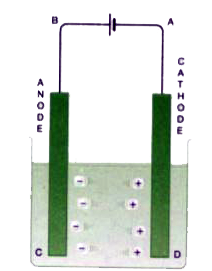In which direction currrent flows in a circuit ?
To determine the direction in which current flows in a circuit, we can follow these steps:
1. Understanding Electric Current:
- Electric current is defined as the rate of flow of electric charge. It is measured in amperes (A) and represents how much charge passes through a point in the circuit per unit time.
Hint: Remember that current is all about the movement of charges.
2. Identifying the Circuit Components:
- In a simple circuit, we typically have a power source (like a battery) and a load (like a bulb). The battery has two terminals: a positive terminal and a negative terminal.
Hint: Visualize the circuit to see where the battery and the load are connected.
3. Flow of Electrons:
- In a circuit, the actual charge carriers are electrons, which are negatively charged particles. Electrons flow from the negative terminal of the battery towards the positive terminal.
Hint: Think of electrons as tiny particles that are moving through the wires.
4. Direction of Current:
- By convention, the direction of electric current is considered to flow from the positive terminal to the negative terminal of the battery. This is opposite to the direction of electron flow.
Hint: Remember the convention: current flows from positive to negative, while electrons flow from negative to positive.
5. Conclusion:
- Therefore, in a circuit, the electric current flows from the positive terminal of the battery to the negative terminal.
Hint: Summarize your findings: current direction is positive to negative.
Final Answer:
The direction of current flow in a circuit is from the positive terminal to the negative terminal of the battery.
- Electric current is defined as the rate of flow of electric charge. It is measured in amperes (A) and represents how much charge passes through a point in the circuit per unit time.
- In a simple circuit, we typically have a power source (like a battery) and a load (like a bulb). The battery has two terminals: a positive terminal and a negative terminal.
- In a circuit, the actual charge carriers are electrons, which are negatively charged particles. Electrons flow from the negative terminal of the battery towards the positive terminal.
- By convention, the direction of electric current is considered to flow from the positive terminal to the negative terminal of the battery. This is opposite to the direction of electron flow.
- Therefore, in a circuit, the electric current flows from the positive terminal of the battery to the negative terminal.
The direction of current flow in a circuit is from the positive terminal to the negative terminal of the battery.
Topper's Solved these Questions
Similar Questions
Knowledge Check
What causes an electric current to flow in a circuit ?
AMovement of electronsBMovement of neutronsCMovement of protonsDMovement of atomsFind the conventional direction of currrent flow in an eletrolytic cell.
 ABCDABB to ACB to C only A to D onlyDA to D only
ABCDABB to ACB to C only A to D onlyDA to D onlyThe current , which is assumed to be flowing in a circuit from positive terminal to negative, is called
Aelectronic currentBconventional currentCalternating currentDpulsating current
(a) In which direction does conventional current flow around a circuit?
(b) In which direction do electrons flow?
View SolutionConsider the circuit

Then, the current flow in the circuit is
View SolutionWhich one of the given four milliammeters shown in (Fig. 3.60) would you use for measurement of current flowing in a circuit ?

View SolutionElectric current flows in ___ direction only.
View SolutionConsider the switching circuit given below :

Then, the current flow in the circuit is
View Solution
